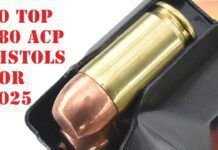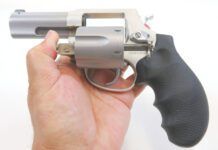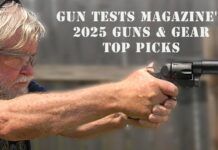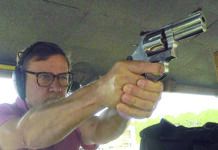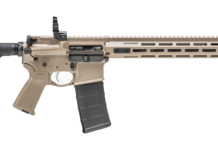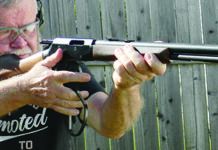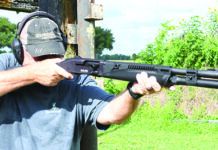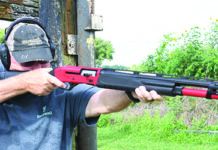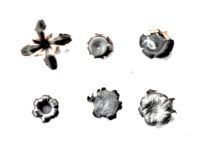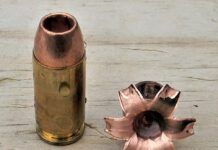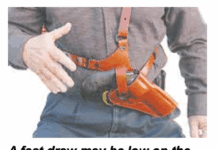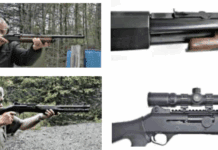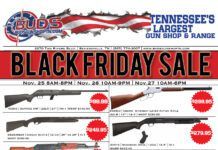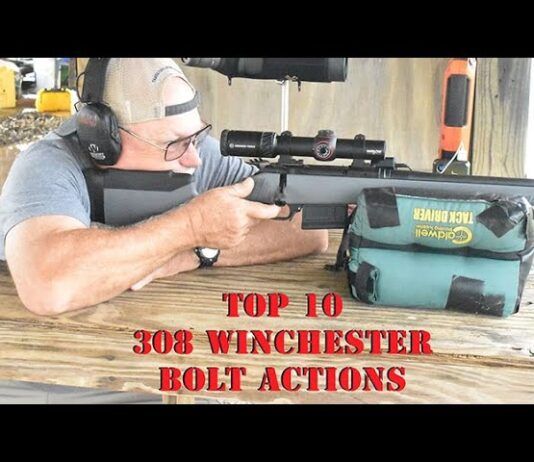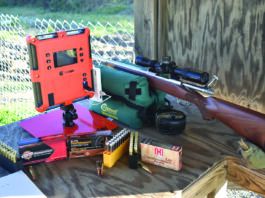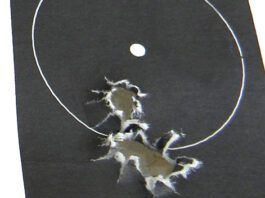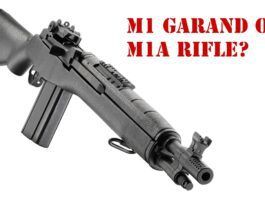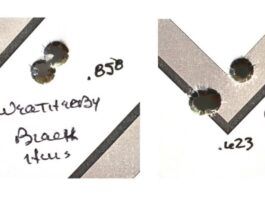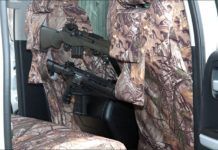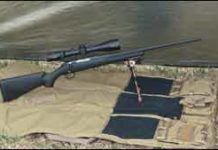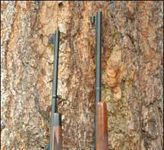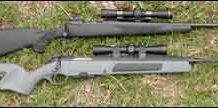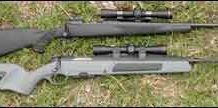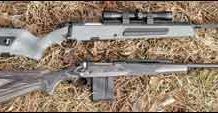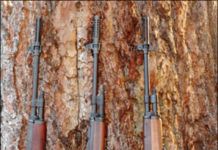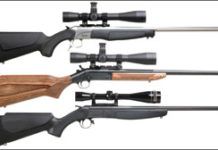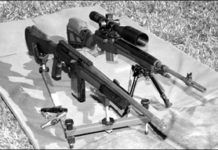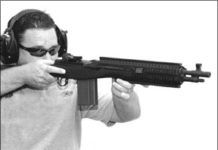308s: Rugers SR-762 Versus Springfield Armorys Socom 16
If you haven't noticed, what used to be called the AR-10 platform has made a comeback. Eugene Stoner's design in 308 Winchester (7.62x51mm NATO) has gone on to unprecedented popularity with military and civilian consumers. But many shooters prefer an even older military-style platform — a compact variation of the M1A rifle, with lineage credited to the John C. Garand M1 rifle. We recently tested two production rifles built on these different platforms, the $2200 Ruger SR-762 and the $1900 Springfield Armory Socom 16, to see which one we'd buy as a handy rifle for self defense, hunting, and all-round fun. Both had barrels around 16 inches long and used gas-piston mechanics to operate.
We began by breaking in each rifle using a variety of rounds featuring different bullet weights. We tried two different types of less-expensive 150-grain 7.62x51 NATO jacketed ball ammunition from MagTech and variety of rounds, such as Black Hills 175-grain boattail hollowpoints that have been known to excel in bolt-action rifles. We settled on three Black Hills rounds that shot the best, the company's 168-grain BTHP, 165-grain Gold Nosler Ballistic Tip, and 155-grain Gold Hornady A-Max ammunition.
For break-in and accuracy shooting, we used the same $310 Leupold FX-II 2.5X28mm IER (extended eye relief) Scout scope No. 58810 on both rifles. That was in part to accommodate the Socom 16, which offered only a short Picatinny rail above the forend. The Ruger SR-762 had a long top rail able to accommodate any type of scope. We could have added a receiver mount to the Socom 16, but, in our view, that would change the platform significantly. For accuracy, we fired five-shot groups from the 100-yard benches at American Shooting Centers in Houston.
Beyond accuracy and reliability we also compared the rifles based on practical handling. This included methods of loading and switching magazines as well as reviewing each gun's strengths and versatility.
243 Win. Bolt-Action Rifles Under $500: Ruger Vs Mossberg
Two 375 H&H Magnum Rifles: Winchester Versus Remington
Some time back a reader asked us which 375 H&H Magnum rifle we'd suggest for his son, who was going to Africa for an extended hunt. He wanted to know if the current crop of Winchesters and Remingtons were any good in that caliber, and which one we'd recommend for his son. We knew Winchester was producing a new Model 70 Winchester, made by FN in the U.S., but had examined only a Lightweight Compact 308 Model 70. We thought it was a pretty good rifle, but those who can make a good 308 cannot necessarily make a good 375. We knew Remington used to make a decent 375, and a quick search of the Remington website showed us a current offering in that caliber. We acquired a new Model 70 Winchester (MSRP $1400) and a new Remington 700 CDL 375 100th Anniversary Edition. (MSRP $1450) and put them to the test. We tested with Hornady Heavy Magnum 300-grain FMJ RN solids and 270-grain Hornady Heavy Magnum SP InterLock, and with handloads using 235-grain Speer Semi-Spitzer Hot Core, 270-grain Hornady Spire-Point, and 300-grain Nosler Partition bullets. Here are our findings.
Fulton Armory UPR Retest
Fulton Armory UPR Retest
Savage Model 10 FCM Scout: Another Competitor for Steyr
The Savage Model 10 Scout is another attempt to emulate the Steyr Jeff Cooper Scout without breaking the bank. In our May 2011 issue, we tested the Steyr Scout against the new Ruger Gunsite Scout rifle, and though we thought the Ruger looked great, we also thought it was too heavy. We wondered why Ruger insisted on such a heavy, if durable, laminated stock for that gun. Savage put a synthetic, all-black stock on its version of the Scout, so we hoped it would 'make weight,' as Cooper used to put it, which means be light enough to equal the original concept, which the Steyr barely does. We acquired a copy of the Savage Scout and put it to the test to see how it compared to the Steyr, with a few notes on the Ruger. This is what we found.
Savage Model 10 FCM Scout: Another Competitor for Steyr
The Savage Model 10 Scout is another attempt to emulate the Steyr Jeff Cooper Scout without breaking the bank. In our May 2011 issue, we tested the Steyr Scout against the new Ruger Gunsite Scout rifle, and though we thought the Ruger looked great, we also thought it was too heavy. We wondered why Ruger insisted on such a heavy, if durable, laminated stock for that gun. Savage put a synthetic, all-black stock on its version of the Scout, so we hoped it would 'make weight,' as Cooper used to put it, which means be light enough to equal the original concept, which the Steyr barely does. We acquired a copy of the Savage Scout and put it to the test to see how it compared to the Steyr, with a few notes on the Ruger. This is what we found.
Is Rugers New Gunsite Scout Rifle a Pretender, or Contender?
Some decades back, the late John Dean "Jeff" Cooper came up with a concept for what he ultimately called a "scout rifle." This was intended to be an all-around rifle, capable of being used for hunting, but especially useful for the lone military scout (an ancient term). The precise details of this light bolt-action rifle concept have been listed here and there over the years. Some of the specs included 308 caliber, minimal length and weight, a forward-mounted scope, possible provisions for clip loading, a suitable sling, and numerous other features that had great value to the late Mr. Cooper and his fans. After years of searching for the best solution, and the construction of several custom rifles that came close to Cooper's ideal, along came Steyr, which incorporated most of Cooper's rifle ideas into the Steyr Scout, which actually had Jeff Cooper's personal monogram on it. The Steyr Scout rifle so pleased Mr. Cooper that, so far as we know, he ceased his efforts to find a better version of his concept. But that did nothing to stop other makers from coming up with rifles that vaguely approximated some of the scout-rifle features, and of course these had the "scout" name attached to them.
Ruger has offered several short 308 rifles, including one a few years ago that also had provisions for a forward-mounted scope. The Frontier rifle was heavy and generally had none of the better features of the Steyr. Savage also has a scout rifle, and we have a test scheduled on one of those in the near future. But now Ruger has again come out with a scout rifle that looks a lot more like it. It even bears the name of the rifle range that Jeff Cooper began—Gunsite—in Arizona. The new Ruger is called the Gunsite Scout.
We thought it would be interesting to compare the new Ruger Gunsite Scout (MSRP $995) with the established and still available Steyr Mannlicher Scout rifle (MSRP $2975 in the limited-edition Jeff Cooper Commemorative package). We checked pricing on AuctionArms.com and found no listings for the new Gunsite rifle. One seller, Northwest Armory in Portland, had two Steyr Scouts in 308 Win. listed with a buy-it-now-price of $1881.
One of our staff loaned us his original Steyr JC Scout for this test. We shot the two rifles with a mixed batch of recovered military ball ammo, with Winchester Match, Hirtenberger 150-grain JSN, and with a handload featuring a 150-grain soft-nose bullet. Here's what we found.
A Trio OF M14s: Springfield, Fulton Armory, Polytech Custom
In the world of 308 auto-loading rifles, the M14 and its look-alikes reign just about supreme. They have it all, looks, power, function, capacity, plus a great variety of stock and accessory configurations from wood to all manner of polymer that can convert an M14 or M1A into just about any configuration you might want, particularly if you have deep pockets. In this test we look at three wood-stocked versions, a remanufactured Chinese-actioned Polytech M14/S that was converted several years ago by Fulton Armory into a mostly GI-part rifle (about $1900), a new Fulton Armory M14 ($2755), and an M1A from Springfield Armory ($1739). The M14/S was fitted with a Burris 2-8X scope in an S&K mount, but the iron sights were still usable with the scope attached. We used both the scope and iron sights to test that rifle so you could see what one of these rifles can do, and used the irons on the other two.
We tested with three types of ball ammunition, the only type recommended in these firearms. It was Federal Gold Medal match, Magtech 150-grain ball from Brazil, and mixed lot of recovered ammunition purchased in bulk with headstamps from Israel, Italy, Belgium, and Canada, which we used unsorted. Here's what we found.
Three Single-Shot Rifles from CVA and H&R in 308 and 30-06
The concept of a single-shot rifle for modern usage goes back quite a few years. Despite the advent of repeating firearms, the single-shot rifle has always held its own, from the Sharps down to the H&R Ultra rifle tested here. Many makers have put together some very fine and also some not-so-fine single shots on a great variety of actions. This test looks at three relatively simple rifles. Two of them are from CVA in the form of the 308-caliber Apex CR4502S ($652) and the less-expensive Scout in 30-06 ($340). We also acquired one of the U.S.-made H&R 1871 Ultra Hunters in 308 (SB2-808, MSRP $374). We tested the 308s with three types of ammunition, Remington 180-grain Core-Lokt, Winchester 150-grain Power Point, and Winchester Supreme 168-grain HPBT match. In the 30-06 CVA Scout we used Winchester 180-grain Power-Point Plus, some M2 ball from Lake City Arsenal, and Speer Nitrex 165-grain JSP. Could the H&R compete against the Spanish-made CVAs? Here's what we found.
308 Semi-Auto Rifles: FNH-USA, Springfield, Fulton, and DSA
Today's semi-automatic rifle is more accurate and easier to care for than ever before. They're also a lot of fun. The most popular platform continues to be the AR-15, but not everyone is satisfied with chambering 22-caliber ammunition. The fact is that a number of calibers are coming (and going) in an attempt to increase stopping power. In this test we will evaluate four semi-automatic rifles chambered for 308 Winchester. The increase in power is significant, and 308 is a time-tested widely available cartridge. Our test rifles were the $2095 DSA SA58 21-inch Bull Barrel, the $1821 FNH USA FNAR, the $2363 Springfield Armory M1A Loaded, and the $1969 Fulton Armory UPR rifle, an AR-style gun is based on Fulton's Titan II lineup. Each one of our rifles, with the exception of the FNAR, was available with options from a menu of upgrades, so we took advantage of this when we could. The FN rifle does come with modular components to help suit the needs of different shooters.
To test our rifles we visited American Shooting Centers in Houston (www.amShootCenters.com). Our first shots from each rifle were to sight in a Nightforce 5.5-22x50mm NXS scope (www.NightforceOptics.com). We chose the Nightforce scope because of its clarity and versatility. It had a mil-dot reticle with see-through mil-dots plus illumination on demand. Pulling outward on the left-side focus supplied an ideal level of illumination. The reticle remained sharply defined at all times.
Because we would be flipping this one scope from rifle to rifle, we needed a system that offered quick, strong, and precise re-mounting. We could have gone with a quick-release unit, but instead we chose Nightforce rings that attached to the base via a half-inch hex nut. We used a 65-inch-pound Seekonk calibrated torque wrench with T-handle ($98, from www.Brownells.com) to make sure the unit was properly locked into place each time. The repeatable zero of the Nightforce scope made sighting in a simple mechanical chore. Suggested retail prices for the rings and scope were $160 and $1700, respectively.
Once we were sighted in, we recorded five-shot groups from the 100-yard line. Support was provided by Caldwell's new 7 rifle rest ($50, from www.Battenfieldtechnologies.com). This unit was a light skeletal structure that supported the rifle beneath the buttstock and the fore-end. The 7 design left plenty of room for the shooter to assume a natural shooting position with the benefit of additional mechanical support. We also fired with a Caldwell Rock Jr. beneath the fore-end with a beanie bag squeezed beneath the buttstock.
Each of our guns was designed as a battle rifle with available high-capacity magazines, so we didn't always take time to let the guns cool between groups. But we did take note of any difference in performance due to barrel temperature. American Shooting Centers offers target boards set out as far as 600 yards. But long-range shooters must first qualify at the 300-yard line. We decided that we'd pick the best ammunition for each rifle and try shooting them from the 300-yard line prone with bipod attached. With our Nightforce scope turned up to 22X, using a spotting scope proved unnecessary.
Our test ammunition consisted of 168-grain Federal Gold Medal Match boattail hollowpoints and two boattail hollowpoints from Black Hills Ammunition weighing 168 grains and 175 grains, respectively. Over our test period we suffered through heavy winds, which we monitored with a Kestral 4000 Weather Station ($255 from sinclairintl.com). Testing for function, accuracy and versatility from four different platforms, here is what we learned.


